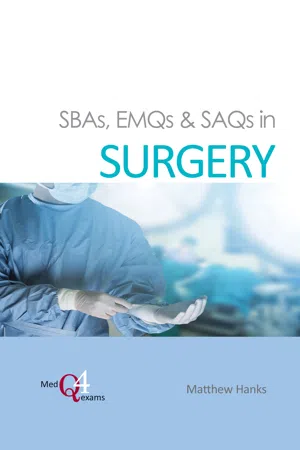![]()
Section 1
Questions
![]()
Chapter 1
Upper GI surgery
QUESTIONS
Single best answer questions
1) A 42-year-old female with known gallstones presents to the emergency department with epigastric pain radiating to the back. The pain started 24 hours ago and is severe in nature. Bloods reveal an amylase at 2000IU/L. What is the most likely diagnosis?
a. Acute pancreatitis.
b. Ascending cholangitis.
c. Chronic pancreatitis.
d. Biliary colic.
2) An 82-year-old male is brought to the emergency department by paramedics following several episodes of haematemesis at home. He is hypotensive and tachycardic. He has a previous history of endovascular repair of an AAA. What condition must be excluded as a cause of this patient’s haematemesis?
a. Aorto-enteric fistula.
b. Mallory-Weiss tear.
c. Gastro-oesophageal reflux disease.
d. Gastritis.
3) A 42-year-old female presents to the surgical assessment unit with a 24-hour history of right upper quadrant pain radiating to the right shoulder. On examination, she is tender in the right upper quadrant with a positive Murphy’s sign. There is no evidence of jaundice. Bloods show a raised WCC and CRP. Liver function tests are unremarkable. What is the most likely diagnosis?
a. Ascending cholangitis.
b. Biliary colic.
c. Acute cholangitis.
d. Choledochal cyst.
4) A 67-year-old male presents to the emergency department with a 48-hour history of vomiting and abdominal pain. He has noted abdominal distention and in the last 24 hours has not opened his bowels or passed any flatus. On examination, he has a distended abdomen and auscultation reveals tinkling bowel sounds. An abdominal X-ray shows central, dilated loops of bowel with valvulae conniventes present on these loops. What is the most likely diagnosis?
a. Duodenal atresia.
b. Bacterial gastroenteritis.
c. Large bowel obstruction.
d. Small bowel obstruction.
5) A 45-year-old male presents to the emergency department with a 24-hour history of vomiting, abdominal pain and constipation. He has not passed any flatus during this time. He has a past medical history of gallstones, previous open repair of a duodenal ulcer and Type 1 diabetes mellitus. On examination, his abdomen is distended and bowel sounds are decreased. Abdominal X-ray shows evidence of a small bowel obstruction with pneumobilia. What is the most likely cause of this patient’s small bowel obstruction?
a. Gastric volvulus.
b. Gallstone ileus.
c. Adhesions.
d. Gastrointestinal stromal tumour.
6) A 56-year-old male is admitted to the surgical assessment unit with a 36-hour history of right upper quadrant pain and vomiting. The pain is worse following food and he has been unable to eat anything for 24 hours. On examination, he has right upper quadrant tenderness but no other findings. Blood results show a raised WCC and CRP. The clerking doctor believes this patient may have acute cholecystitis. What is the most appropriate next investigation to request for this patient?
a. Ultrasound abdomen.
b. MRCP.
c. ERCP.
d. Abdominal X-ray.
7) A 56-year-old male presents to the outpatient clinic with a 4-week history of dysphagia. He has had a feeling of a lump in his throat for the past 3 weeks and has had several episodes of regurgitating food. On examination, a prominent lump is seen on swallowing and the patient appears to take a double swallow. A barium swallow confirms the diagnosis. What is the most likely diagnosis?
a. Oesophageal perforation.
b. Pharyngeal pouch.
c. Oesophageal web.
d. Achalasia.
8) A 42-year-old female presents to the surgical outpatient clinic with a 12-week history of dyspepsia which is worst when lying flat and has not settled with a trial of proton pump inhibitor therapy. She has experienced issues with regurgitating food soon after eating several times over the past 5 weeks which is distressing her. An oesophago-gastroduodenoscopy (OGD) is performed which shows an upward displacement of the gastro-oesophageal junction. What is the underlying diagnosis?
a. Barrett’s oesophagus.
b. Gastro-oesophageal reflux disease.
c. Sliding hiatus hernia.
d. Rolling hiatus hernia.
9) A 67-year-old female presents to the outpatient surgical clinic with a 6-week history of vague abdominal pain, nausea and diarrhoea. She believes her clothes feel looser than previously and her friends have commented that she has a flushed appearance. Blood results show a raised serotonin level. What is the underlying diagnosis?
a. Carcinoid.
b. Gastrointestinal stromal tumour.
c. Cholangiocarcinoma.
d. Gallbladder empyema.
10) A 45-year-old female presents to the emergency department with right upper quadrant pain, lethargy and fever. She had a recent hospital admission in which she was treated for acute cholecystitis. Observations in the department show a tachycardia and swinging pyrexia. Blood results show a raised WCC and CRP. LFTs were unremarkable....
